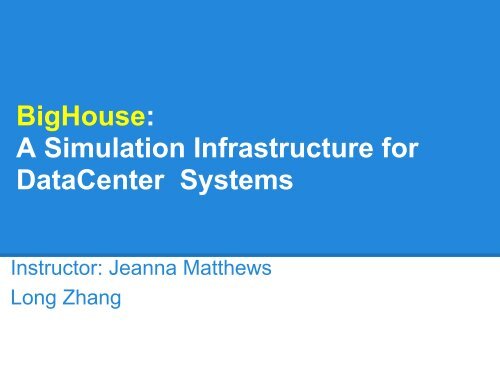BigHouse: A Simulation Infrastructure for DataCenter Systems
BigHouse: A Simulation Infrastructure for DataCenter Systems
BigHouse: A Simulation Infrastructure for DataCenter Systems
Create successful ePaper yourself
Turn your PDF publications into a flip-book with our unique Google optimized e-Paper software.
<strong>BigHouse</strong>:<br />
A <strong>Simulation</strong> <strong>Infrastructure</strong> <strong>for</strong><br />
<strong>DataCenter</strong> <strong>Systems</strong><br />
Instructor: Jeanna Matthews<br />
Long Zhang
Outline<br />
• Introduction to <strong>Simulation</strong><br />
• <strong>BigHouse</strong> Simulator<br />
• Case Studies<br />
• Evaluation<br />
• Conclusion & Our Simulator
Datacenter Research is Challenging<br />
• Tools only evaluate a single component<br />
– Processor,caches,DRAM,disks,etc…<br />
• Evaluating an entire server is difficult<br />
– Requires coordination of many slow tools<br />
– Models far too much detail
Requirements <strong>for</strong> Datacenter <strong>Simulation</strong><br />
• Handle scope of data center problems<br />
–E.g., Per<strong>for</strong>mance, power, thermal, reliability<br />
–Goal: General modeling infrastructure<br />
• Publicly distributable<br />
–Goal: Does not rely on proprietary binaries<br />
• Needs to simulate 1 to 10,000 servers<br />
–Goal: Scalable to clusters of machines
The <strong>BigHouse</strong> Simulator<br />
• Framework <strong>for</strong> simulating data center systems<br />
– Discrete--‐event simulation statistical rigor<br />
– Easily extensible to new domains<br />
• Claim: Queuing theory is correct abstraction<br />
– Simulate at the granularity of requests/tasks<br />
(i.e.,request enters/exits a server)<br />
– Represent workloads as statistical distributions<br />
– Stochastic approach allows parallelization
<strong>BigHouse</strong> Overview<br />
Stochastic queuing simulation methodology:<br />
1. Workload characterization<br />
2. System modeling<br />
3. Statistically--‐rigorous discrete--‐event simulation
<strong>BigHouse</strong> Features<br />
<strong>BigHouse</strong> provides:<br />
• Base objects <strong>for</strong> modeling (extend with object--‐oriented<br />
programming)<br />
• Statistical probes to instrument object metrics(per--‐task)<br />
• Statistically--‐rigorous sampling of outputs parallel histogram<br />
approx.<br />
• Automatic parallelization across cores/machines<br />
User provides:<br />
• Model to represent new behavior (e.g.,Markov chain to<br />
modulate queue)<br />
• New workload distributions (or reuse existing workload suite)
Workload Characterization<br />
• May need to capture more complicated effect<br />
(e.g., correlation)<br />
• Similar to statistical simulation
System Modeling<br />
Observations of system model fed to statistical probes
Statistics Sub--System<br />
Automatically determines simulation convergence
Case Study 1:Google Web Search
Web Search Model<br />
CPU and Memory per<strong>for</strong>mance modulate service rate
Web Search Model Validation<br />
<strong>Simulation</strong> accurately predicts saturation points Average<br />
error of 9.2%(relative processor slowdown)
Case Study 2:Power Capping<br />
Better use of power infrastructure =large gains<br />
– Throttle power DVFS during infrequent spikes<br />
– Power Capping --‐~40% more servers<br />
Dynamic Voltage and Frequency Scaling
Power Capping Model<br />
CPU and Memory per<strong>for</strong>mance modulate service rate
Our Simulator - Architecture
Conclusion<br />
• <strong>BigHouse</strong>:<strong>Simulation</strong> tool <strong>for</strong> data center systems<br />
– Turnaround of hours rather than days<br />
– Statistically rigorous<br />
– Parallelizable<br />
• Community engagement<br />
– Workload repository<br />
– New system models<br />
– Validation at scale
*THANK YOU*<br />
Q?

















